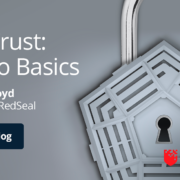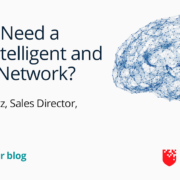Zero Trust: Back to Basics
The Executive Order on Improving the Nation’s Cybersecurity in 2021 requires agencies to move towards zero trust in a meaningful way as part of modernizing infrastructure. Yet, federal agencies typically find it challenging to implement zero trust. While fine in theory, the challenge often lies in the legacy systems and on-premises networks that exist with tendrils reaching into multiple locations, including many which are unknown.
Identity management and authentication tools are an important part of network security, but before you can truly implement zero trust, you need an understanding of your entire infrastructure. Zero trust isn’t just about identity. It’s also about connectivity.
Take a quick detour here. Let’s say you’re driving a tractor-trailer hauling an oversized load. You ask Google Maps to take you the fastest route and it plots it out for you. However, you find that one of the routes is a one-lane dirt road and you can’t fit your rig. So, you go back to your mapping software and find alternate routes. Depending on how much time you have, the number of alternative pathways to your final destination is endless.
Computer security needs to think this way, too. Even if you’ve blocked the path for threat actors in one connection, how else could they get to their destination? While you may think traffic only flows one way on your network, most organizations find there are multiple pathways they never knew (or even thought) about.
To put in efficient security controls, you need to go back to basics with zero trust. That starts with understanding every device, application, and connection on your infrastructure.
Zero Trust Embodies Fundamental Best-Practice Security Concepts
Zero trust returns to the basics of good cybersecurity by assuming there is no traditional network edge. Whether it’s local, in the cloud, or any combination of hybrid resources across your infrastructure, you need a security framework that requires everyone touching your resources to be authenticated, authorized, and continuously validated.
By providing a balance between security and usability, zero trust makes it more difficult for attackers to compromise your network and access data. While providing users with authorized access to get their work done, zero-trust frameworks prevent unauthorized access and lateral movement.
By properly segmenting your network and requiring authentication at each stage, you can limit the damage even if someone does get inside your network. However, this requires a firm understanding of every device and application that are part of your infrastructure as well as your users.
Putting Zero Trust to Work
The National Institute of Standards and Technology (NIST) Risk Management Framework publication 800-207 provides the conceptual framework for zero trust that government agencies need to adopt.
The risk management framework has seven steps:
- Prepare: mapping and analyzing the network
- Categorize: assess risk at each stage and prioritize
- Select: determine appropriate controls
- Implement: deploy zero trust solutions
- Assess: ensure solutions and policies are operating as intended
- Authorize: certify systems and workflow are ready for operation
- Monitor: provide continuous monitoring of security posture
In NIST’s subsequent draft white paper on planning for a zero-trust architecture, it reinforces the crucial first step, which is mapping the attack surface and identifying the key parts that could be targeted by a threat actor.
Instituting zero trust security requires detailed analysis and information gathering on devices, applications, connectivity, and users. Only when you understand how data moves through your network and all the different ways it can move through your network can you implement segmentation and zero trust.
Analysts should identify options to streamline processes, consolidate tools and applications, and sunset any vulnerable devices or access points. This includes defunct user accounts and any non-compliant resources.
Use Advanced Technology to Help You Perform Network Analysis
Trying to map your network manually is nearly impossible. No matter how many people you task to help and how long you have, things will get missed. Every device, appliance, configuration, and connection has to be analyzed. Third parties and connections to outside sources need to be evaluated. At the same time you’re conducting this inventory, things are in a constant state of change which makes it even easier to miss key components.
Yet, this inventory is the foundation for implementing zero trust. If you miss something, you leave security gaps within your infrastructure.
The right network mapping software for government agencies can automate this process by going out and gathering the information for you. Net mapping analysis can calculate every possible pathway through the network, taking into account NATS messaging and load balancing. During this stage, most organizations uncover a surprising number of previously unknown pathways. Each connection point needs to be assessed for need and whether it can be closed to reduce attack surfaces.
Automated network mapping will also provide an inventory of all the gear on your network and IP space in addition to your cloud and software-defined network (SDN) assets. Zero trust requires you to identify who and what can access your network, and who should have that access.
Once you have conducted this exhaustive inventory, you can then begin to implement the zero-trust policies with confidence.
Since your network is in a constant state of evolution with new users, devices, applications, and connectivity being added, changed, or revised, you also need continuous monitoring of your network infrastructure to ensure changes remain compliant with your security policies.
Back to the Basics
The conversation about zero trust often focuses narrowly on identity. Equally important are device inventory and connectivity. The underlying goal of zero trust is allowing only specific authorized individuals to access specific things on specific devices. Before you can put in place adequate security controls, you need to know about all of the devices and all the connections.
RedSeal provides network mapping, inventory, and mission-critical security and compliance services for government agencies and businesses and is Common Criteria certified. To learn more about implementing a zero-trust framework, you need to better understand the challenges and strategies for successful zero-trust implementation.
Download our Zero Trust Guide today to get started.









